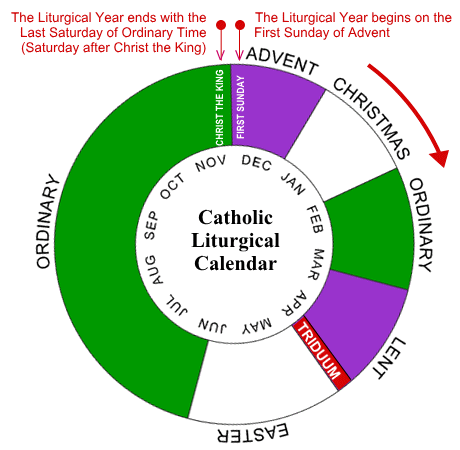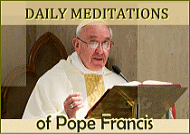
The Liturgical Calendar

The Liturgical Year is the year-long unfolding of the whole “mystery of Christ”, made special by the Seasons (Cycles of celebration) during the year. The Church through her public worship recalls and celebrates these mysteries, dispensing to her members the treasure of Christ’s merits, so that these are made present at all times. The Liturgical Year begins on the first Sunday of Advent, which usually occurs around the end of November/ beginning of December and runs through to the Solemnity of Christ the King.
A GRAPHIC REPRESENTATION OF THE LITURGICAL YEAR

The Liturgical Year consists of six liturgical seasons: Advent, Christmas, Ordinary Time after Epiphany, Lent (& Triduum), Easter, and Ordinary Time after Pentecost. Seasons begin or end based on a movable feast and so some seasons vary in length from year to year, and vary according to the dates of the calendar.
ADVENT (a season of four weeks), is the time of preparation for both the celebration of Jesus’ birth and his Second Coming. This season lasts until 24 December (Christmas Eve).
CHRISTMASTIDE follows, beginning with First Vespers of Christmas on the evening of 24 December and ending with the Feast of the Baptism of the Lord (Sunday after January 6).
ORDINARY TIME I or TIME AFTER EPIPHANY, extends from the day following the Feast of the Baptism of Christ until the day before Ash Wednesday. It contains anywhere from three to eight Sundays, depending on when Easter falls. (There are 2 periods of Ordinary Time in the year. These are the common weeks which do not belong to a proper season.)
LENT is a major penitential season of preparation for Easter. It begins on Ash Wednesday, which occurs between February 4 and March 11, and lasts for forty days, since the six Sundays within the season are not counted. Ash Wednesday is 46 days before Easter Sunday. The week before Easter is called “Holy Week” and opens with Passion or Palm Sunday, recalling Jesus’ triumphant entry into Jerusalem.
EASTER TRIDUUM in Holy Week begins with evening Mass of the Lord’s Supper and ends with Evening Prayer on Easter Sunday. In this period we celebrate Maundy Thursday (Mass of the Lord’s Supper and the Commemoration of Holy Orders and the Chrism Mass in the morning), Good Friday (Commemoration of the Passion of the Lord) and Holy Saturday (the day during which Christ lay in the tomb). The Easter Vigil is held on the night between Holy Saturday and Easter Sunday. The central celebration of the Easter Triduum is the key to the liturgical calendar as it commemorates the supreme saving act of Jesus in his death and resurrection to which all other observances and acts of worship are related.
EASTER is the celebration of Jesus’ resurrection. The date of Easter varies from year to year and occurs between March 22 and April 25. Beginning with Easter Sunday, the Church celebrates an Octave (8 days) of the Resurrection – Easter Monday, Easter Tuesday, etc. Each day of the Octave is a Solemnity, in essence, an extension of Easter Sunday. The Octave of Easter (Sunday after Easter Sunday) is called Mercy Sunday. The Easter Season extends from the Easter Vigil through Pentecost Sunday, which is the fiftieth and last day of the Easter season. It celebrates the sending of the Holy Spirit to the Apostles, which marks the birth of the Church.
ORDINARY TIME II or TIME AFTER PENTECOST – follows the Easter season and the feasts of Easter, Ascension, and Pentecost resumes on Pentecost Monday. It ends on the Saturday before the First Sunday of Advent. Important Feasts during this season include:
Trinity Sunday, the First Sunday after Pentecost;
Corpus Christi, the Second Sunday after Pentecost;
Feast of the Sacred Heart of Jesus, Friday in the third week after Pentecost;
Feast of Christ the King, the Last Sunday before Advent.
The dates of Ash Wednesday and Easter Sunday
for years of current interest are as follows:
| CALENDAR YEAR | ASH WEDNESDAY | EASTER SUNDAY |
| 2011 | March 9 | April 24 |
| 2012 | February 22 | April 8 |
| 2013 | February 13 | March 31 |
| 2014 | March 5 | April 20 |
| 2015 | February 18 | April 5 |
| 2016 | February 10 | March 27 |
| 2017 | March 1 | April 16 |
| 2018 | February 14 | April 1 |
| 2019 | March 6 | April 21 |
| 2020 | February 26 | April 12 |

The Liturgical Cycle

The Lectionary (Mass readings from the Bible) follows a Sunday Cycle and a Weekday Cycle.
The Sunday Cycle is 3-yearly and denoted by the letters A, B and C. 2011 was Year A, 2012 was Year B, 2013 is Year C, etc. The year of the cycle changes on the First Sunday of Advent which is the beginning of the liturgical year. Each year follows through one of the Gospels: A-Matthew, B-Mark, C-Luke. The Gospel of John is proclaimed on particular Sundays in each of the years.
Weekdays in Ordinary Time follow a 2 year cycle numbered I and II. Year I is read in odd number years such as 2011, 2013, 2015, etc. Year II is read in even years such as 2010, 2012, 2014, etc.

Liturgical Seasons
and Vestment Colours

Vestment colours are used to represent the mood of the Mass being celebrated. There are four principal vestment colours:
Violet: Represents expectation, purification or Penance. It is used during Lent and Advent. It may also be worn for Funerals.
White (or Gold): Represents joy and triumph. It is used during the Paschal Triduum, Easter and Christmas, also on celebrations of the Lord (other than of his Passion), of the Blessed Virgin Mary, of the Holy Angels, and of Saints who were not Martyrs.
Red: Represents royalty, fire and martyrdom. It is used on Palm Sunday and Good Friday, on Pentecost Sunday, on celebrations of the Lord’s Passion, on “birthday” feasts of the Apostles and Evangelists, and on celebrations of martyred Saints.
Green: Represents life and growth. It is used in Ordinary Time.
Other colours may also be used, like Black for funerals and Rose on the third Sunday of Advent and Laetare Sunday (Fourth Sunday of Lent). On more solemn days, festive, that is, more precious, sacred vestments may be used, even if not of the colour of the day.

